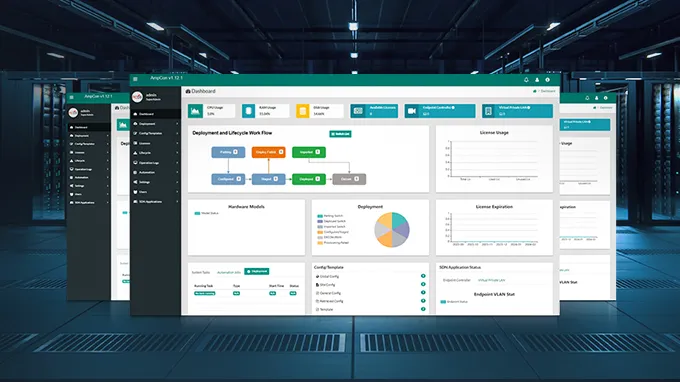25G/100G Ethernet Solutions for Campus Networks
The ever-increasing traffic growth from video streaming, high-performance computing (HPC), and cloud applications are driving the need for faster and higher-capacity campus network solutions. That's why the 25G/100G Ethernet solution is gaining momentum.
What is 25G/100G Ethernet Solution?
In a 25G/100G campus network, the uplink bandwidth is typically 25G from the access layer to the distribution layer, and 100G from the distribution layer to the core layer. Typically, 25G/100G upgrade solutions drive campus networks toward higher performance and scalability.
Ever since the IEEE 25G standard was released back in 2015, the 25G/100G Ethernet solution has grown increasingly popular as an optimal campus network solution due to various advantages it offers. Early reports have also shown that 25G/100G Ethernet solutions have a promising future in data center networks.

Key Benefits of 25G/100G Solution
25G/100G Ethernet solutions come with a wide range of benefits such as high density and flexibility. Let's dig deeper into how 25G/100G Ethernet solutions bring out the best of campus networks.
Improved Network Bandwidth
In a 25G/100G Ethernet solution, the data link bandwidth between the access layer and the distribution layer is upgraded from 10G to 25G, and the data link bandwidth between the distribution layer and the core layer is upgraded from 40G to 100G.
Good Compatibility with Transceiver Modules
25G SFP28 transceiver modules and 10G SFP+ transceiver modules have the same form factor. Therefore, 25G SFP28 ports support 10G SFP+ transceiver modules, and support a rate of 10 Gbps. Likewise, 100G QSFP28 ports are compatible with existing 40G QSFP+ transceiver modules, thus supporting a data rate of 40 Gbps.
Optical Fiber Reuse
If a 10G/40G campus network needs an upgrade to 25G/100G, the optical fibers used on the previous network can still be used for the new 25G/100G solution. This is because 25G SFP28 transceiver modules, be they single-mode or multi-mode, use LC connectors like 10G SFP+ transceiver modules. And 100G QSFP28 transceiver modules support MPO or LC connectors as 40G QSFP+ transceiver modules do.
Reduced Power Consumption
The 25G/100G Ethernet solution can remarkably bring power consumption per unit bandwidth down. Take FS transceiver modules with a maximum reach of 10 km as an example. Other parameters being equal (media, transmitter and receive type), compared to FS 10G SFP+ SMF transceiver modules, FS 25G SFP28 SMF transceiver modules improve network bandwidth by 1.5 times without any increase in maximum power consumption.
Key Technologies in 25G/100G Solution
The high performance of the 25G/100G Ethernet solution is not possible without a number of cutting edge technologies. The following shows some key technologies used in 25G/100G Ethernet solutions.
SerDes
A SerDes, short for serializer/deserializer, is a pair of functional blocks able to convert parallel data to serial data, or vice versa. The serializer, also called SerDes sender (TX), serializes and transmits the received data to the deserializer at the other end. The deserializer, or SerDes receiver (Rx), reconstructs the serialized data. The primary purpose of SerDes is to minimize the number of I/O pins and interconnects and speed up data communication.

FEC
FEC (Forward Error Correction) refers to a method of error control in data transmission where the transmitter adds error correction information to received data message and the receiver recognizes part of the data without the error correction information. This technology helps lower the Bit Error Rate (BER) in the data transmission process, thus improving the overall signal quality. However, FEC also comes with its fair share of limitations such as data redundancy and transmission latency.

PAM4
PAM4, short for 4-level pulse amplitude modulation, is a multilevel signal modulation method used in high-speed signal interconnection. Unlike NRZ, PAM4 uses four different signal levels,namely 00, 01, 10, and 11, to transmit data, each level cycle transmitting 2-bit logic information.
Used on transceiver modules, this technology makes it possible to increase bandwidth and improve performance without having to configure more fibers. In addition, lag is not likely to occur as transmission rate grows, enabling high-performance 25G/100G networks.

FS 25G/100G Products for Campus Networks
FS provides a complete portfolio of 25G/100G products to help you upgrade to 25G/100G network solutions. Here is a list of high-performance 25G/100G switches and transceiver modules for your campus networks.
| category | Products | Features | |
|---|---|---|---|
| 25G | Switch | 25G Enterprise Switches |
|
| 25G Data Center Switches |
|
||
| Transceiver Module | 25G SFP28 |
|
|
| 25G BiDi SFP28 |
|
||
| 25G WDM SFP28 |
|
||
| DAC & AOC | 25G SFP28 DAC |
|
|
| 25G SFP28 AOC |
|
||
| 100G | Switch | 100G Enterprise Switches |
|
| 100G Data Center Switches |
|
||
| Transceiver Module | 100G QSFP28 |
|
|
| 100G CFP/CFP2/CFP4 |
|
||
| DAC & AOC | 100G QSFP28 DAC/AOC |
|
|
| 100G QSFP28 to 2x QSFP28 DAC/AOC | 100G QSFP28 to 4x SFP28 DAC/AOC |
|
With high bandwidth, low power consumption, and high density, the 25G/100G Ethernet solution is driving campus networks to a new level. Its values have been recognized by more and more enterprises and universities.
You might be interested in
Email Address

-
PoE vs PoE+ vs PoE++ Switch: How to Choose?
May 30, 2024














